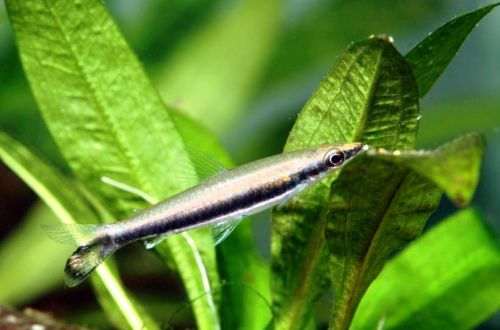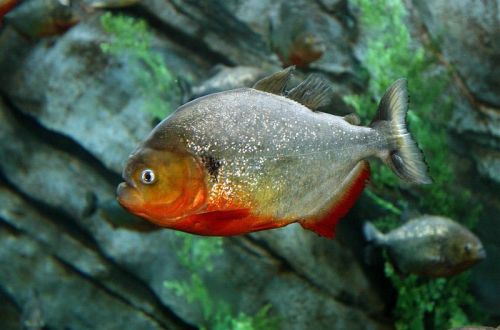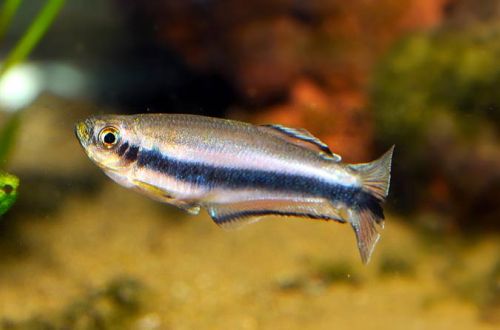
Nannostomus unilateral
Nannostomus unifasciatus, scientific name Nannostomus unifasciatus, belongs to the Lebiasinidae family. A popular aquarium fish, characterized by an unusual oblique swimming style, which is not characteristic of other members of this family. Considered easy to keep, although breeding will be difficult and likely out of the reach of beginner aquarists.

Contents
Habitat
It comes from South America from the upper Amazon basin from the territory of the western states of Brazil and Bolivia. Wild populations have also been introduced to the islands of Trinidad and Tobago. It inhabits small tributaries, rivers, swamps, as well as floodplain lakes and flooded areas of tropical forests during the rainy season. They prefer regions with a slow current and dense thickets of aquatic plants.
Brief information:
- The volume of the aquarium – from 60 liters.
- Temperature – 23-28°C
- Value pH — 4.0–7.0
- Water hardness – 1–10 dGH
- Substrate type – any
- Lighting – subdued, moderate
- Brackish water – no
- Water movement – little or no
- The size of the fish is about 4 cm.
- Food – any food
- Temperament – peaceful
- Content in a group of 10 individuals
Description
Adult individuals reach a length of about 4 cm. Males, unlike females, look somewhat slimmer and have an enlarged anal fin decorated with a red dot. The coloration is silvery, a wide dark stripe runs along the lower part of the body, passing to the anal and caudal fins.
Food
In a home aquarium, they will accept a variety of foods of a suitable size. The daily diet can consist exclusively of dry foods in the form of flakes, granules, provided that they contain all the necessary vitamins and minerals.
Maintenance and care, arrangement of the aquarium
The optimal size of an aquarium for a flock of 10 fish starts from 60–70 liters. It is recommended to keep in an aquarium with dense aquatic vegetation. In the design, it is preferable to use a dark substrate and clusters of floating plants. Around the latter, fish like to gather near the surface.
Additional decorative elements can be natural snags and leaves of some trees. They will become not only part of the design, but will serve as a means of giving water a chemical composition similar to that in which fish live in nature, due to the release of tannins in the process of decomposition of plant organic matter.
Successful long-term keeping of Nannostomus uniband depends on maintaining stable water conditions within an acceptable range of temperatures and hydrochemical values. To achieve this goal, regular cleaning of the aquarium and weekly replacement of part of the water (15–20% of the volume) with fresh water are carried out. The minimum list of equipment consists of filters, a heater and a lighting system.
Behavior and Compatibility
Peaceful schooling fish, which should be in large groups of at least 10 individuals of both sexes. Males compete with each other for the attention of females, but it does not come to serious skirmishes. Compatible with other non-aggressive species of comparable size.
Breeding / breeding
At the time of writing, no successful cases of breeding this species in home aquaria have been recorded. Known information seems to refer to other related species.
Fish diseases
Diseases inherent in this particular species of fish were not noted. When kept in suitable conditions (high water quality, balanced diet, non-conflict neighbors, etc.), health problems are not observed. The most common cause of disease is the deterioration of conditions leading to immune suppression, which makes the fish susceptible to infections that are invariably present in the surrounding area. When the first signs of an illness are detected (lethargy, exhaustion, refusal of food, lowered fins, etc.), it is necessary to immediately check the main parameters of the water. Often, the restoration of acceptable living conditions contributes to self-healing, but if the fish is too weak or has received obvious damage, medical treatment will be required. For more information on symptoms and treatments, see the Aquarium Fish Diseases section.





